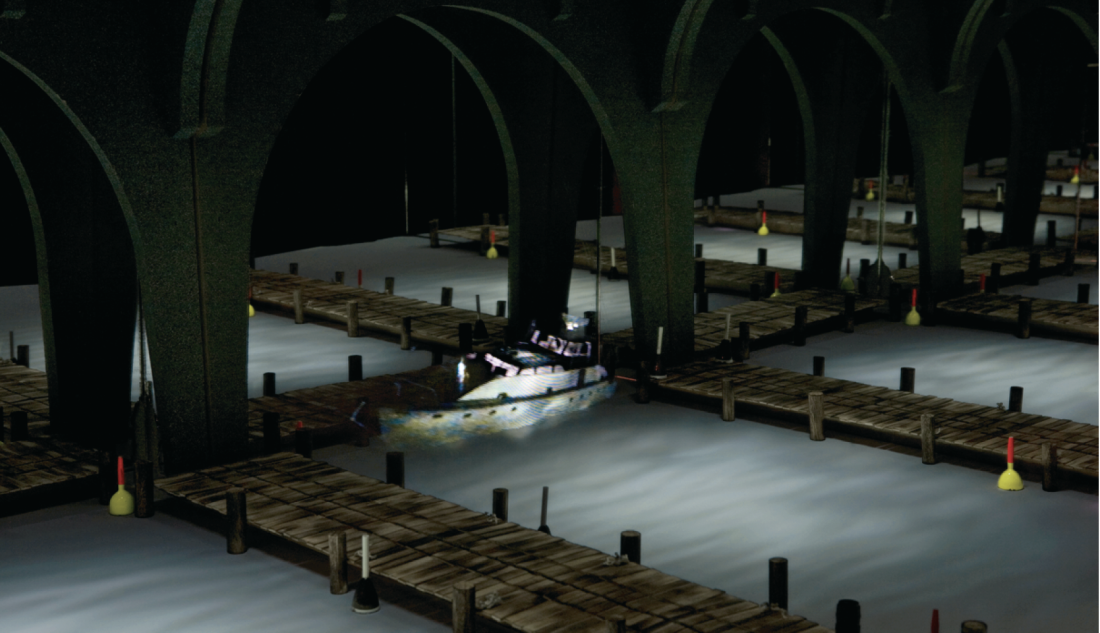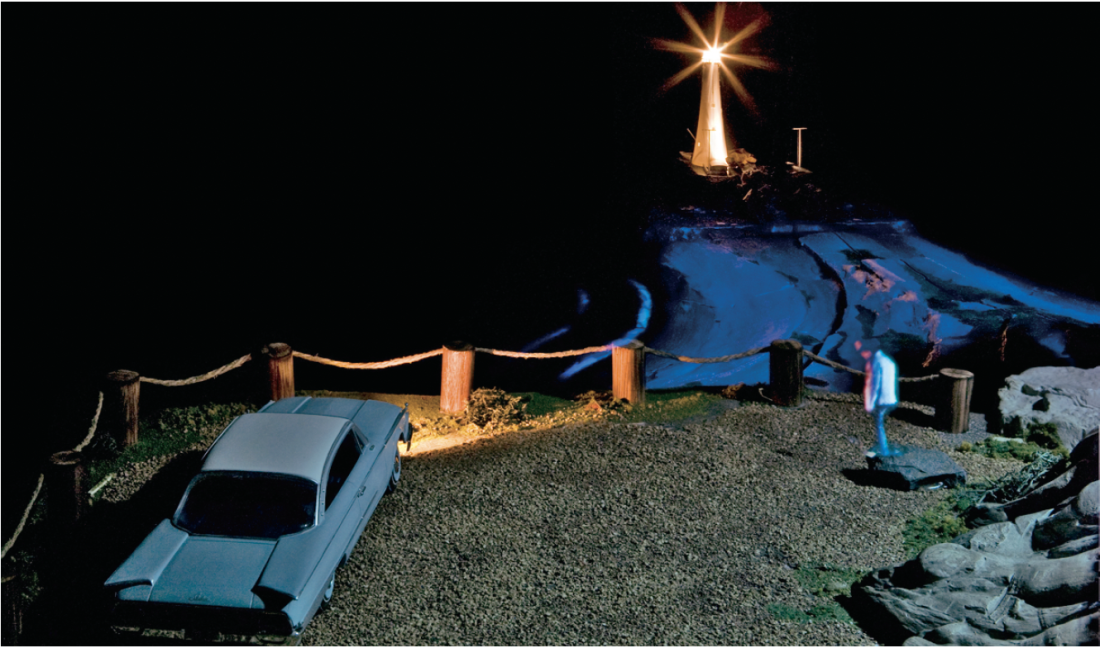David Hoffos
A smudge, probably from the nose of a curious spectator, is imprinted on the glass panel that separates the exhibition space from the model-world of David Hoffos’s Treehouse, 2007. The fact that someone would get so close to the scene as to actually bump into it testifies to the remarkable illusions David Hoffos has created in his “Scenes from the House Dream,” and reminds us of the work’s materiality. His illusions seduce the spectator into a complex system of scrappy looking CRT video monitors, DVD players, black tape, mirrors, lights and glass, all of which are perfectly aligned to reflect hologram-like figures into meticulously constructed dioramas. The collision of these low-tech materials with the fantastic illusions they produce draws the viewer both into—and out of—each installation.

David Hoffos, Scenes from the House Dream: 65-Footers (detail), 2003. Photograph: David Miller. Courtesy the Art Gallery of Nova Scotia, The National Gallery of Canada and Trepanier Baer, Calgary.
Hoffos’s exhibition at the National Gallery brings together the entirety of his Scenes from the House Dream, a five-year project developed between 2003 and 2008. After passing through the black velvet curtain that seals the exhibition hall off from the other galleries, the visitor enters a two-or three-metre-wide winding corridor that directs them through a series of 20 video installations that flicker and glow in the dark. With the exception of a few life-size video projections, each installation consists of a small diorama set into a temporary wall with one to three video monitors positioned around it. The video monitors, located on the spectator’s side of the temporary wall, project semi-transparent illusions—humans, fireworks, drapes blowing in the wind—into Hoffos’s intricate dioramas. The spectator witnesses what appear to be holograms or ghosts hovering within their spaces, acting out short narratives. Most involve one or several characters killing time in the darkness of the night. Each installation places the spectator between two distinct elements: the projection apparatus—the television monitors, often masked off with black tape—and the illusion, a small glass window that encloses the miniature diorama.
The wonder of Hoffos’s installations lies less in the stories they tell than in their low-tech special effects. This became most apparent in the encounter with 65 Footers, 2003, a glowing scene of an expansive harbour deserted of all but a single yacht rocking monotonously. A woman, illuminated by the teal-tinged water, paces back and forth on deck. Beyond this, nothing much appears to happen. It was only when I got a bit too curious and a bit too close that the scene’s full potential emerged, that it became fully animated. As I approached the diorama, first the woman disappeared, then the yacht. Unknowingly, I, the spectator, was not only blocking the projection but also interfering with the narrative. Although seemingly coincidental, this inevitable disruption was strategically directed by the artist. While the illusion itself was not particularly exciting, I was gripped by the liveness of the effect, by the magic that existed in the space between the diorama and the monitors. Hoffos’s installations are designed to absorb the spectator within their relational structures, to choreograph curiosity by spatializing the trick.

David Hoffos, Scenes from the House Dream: Bachelor’s Bluff (detail), 2005. Photograph: David Miller. Courtesy the MacKenzie Art Gallery, Regina, and The Whitney Museum of American Art, New York.
At about the half-way point of the exhibition, I stumbled across a binocular-shaped hole in the temporary wall. It was as if Hoffos had anticipated my curiosity. Peering inside, I was offered a glimpse behind the scenes: a number of crates, the backsides of mirrors that encased Hoffos’s dioramas, and a peculiar projection of a cat sitting against a wall several metres away. This cat, a red herring of sorts, made me instantly realize that the whole mystery of Hoffos’s process lay in plain sight, on the spectator’s side of the temporary wall. Perhaps it is this reversal of the conventional cinematic apparatus, where the “window on the world” is directly and materially accessible to the spectator, that makes Hoffos’s installations so compelling.
Hoffos’s Scenes are undoubtedly some of Canada’s most exciting and thought-provoking recent experiments with video installation. They take advantage of the specificities of the museum to create unfamiliar spectatorial experiences: magical, personal, relational encounters with everyday materials. Spatialized cinema at its best, they inspire a double fascination—with the image and the apparatus, and more precisely, with the immaterial space in between. ❚
David Hoffos’s “Scenes from the House Dream” was exhibited at the National Gallery of Canada in Ottawa from November 6, 2009, to February 14, 2010.
Steve Lyons is a visual artist and writer based in Montreal. Ania Wroblewski is a PhD candidate at Université de Montréal.

